Jordan stretches between the desert and the fertile valley of the Jordan River, holding centuries of human memory in its soil. The Islamic historical places in Jordan offer more than spiritual meaning; they are part of the land’s living identity. Known for its role in Islamic and biblical history, it has always been a place where civilisations paused and left their mark. From silent desert outposts to bustling mosque courtyards, these places carry stories of prophets, companions, and faithful communities who shaped the region across time.
10 Islamic Historical Places In Jordan
These are the Islamic historical places in Jordan that hold the memories of prophets and rulers who shaped the region’s spiritual and cultural journey
1. King Abdullah I Mosque, Amman

Photo: Berthold Werner / Wikimedia Commons
The King Abdullah I Mosque rises from the hills of central Amman with its blue dome and wide marble courtyard. It was built in the late 1980s to honour Jordan’s first monarch, reflecting the nation’s Islamic roots. This mosque offers a unique chance to see how religious expression continues in present-day Jordan. The prayer hall is circular, vast, and beautifully lit with natural light. Intricate Quranic calligraphy lines the interior, and the subtle blue hues echo sky and tradition. As one of the most visited Islamic historical places in Jordan, it is open to visitors from all backgrounds.
How To Reach: Located in the Abdali area of Amman. Easily accessible by taxi or public buses from any part of the city.
Cost: Free for worshippers
Timings: 8 AM – 11 AM and 12.30 PM – 2 PM (Saturday to Thursday). (Closed on Fridays)
Nearby Attractions: Jordan Museum, Rainbow Street, Roman Amphitheatre.
2. Prophet Shu’ayb’s Shrine, Salt
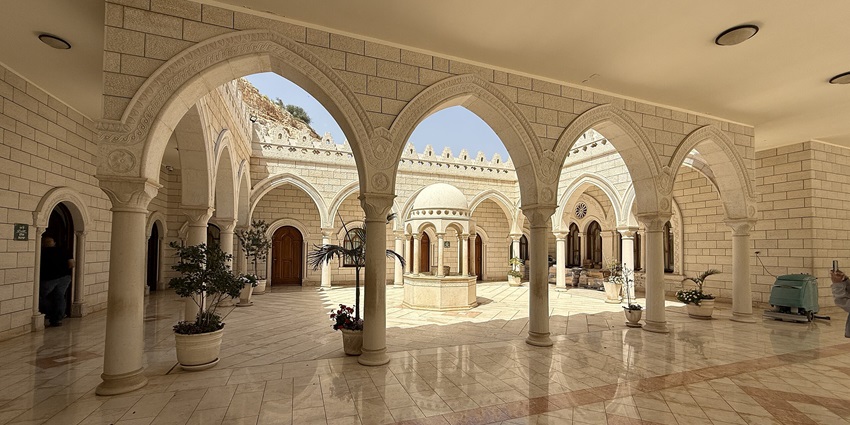
Photo: שלמה רודד / Wikimedia Commons
Outside the town of Salt lies the shrine of Prophet Shu’ayb, one of the most revered figures in Islamic tradition. Local belief holds this to be the final resting place of the prophet, the guide to the people of Madyan. As part of the network of Islamic historical places in Jordan, this shrine reflects the deep respect that still surrounds prophets and their legacies. It is serene, framed by stone walls and gentle slopes, and carries a sense of dignity that goes beyond the physical structure. The shrine is small and modest, with a domed roof and whitewashed interiors.
How To Reach: 30 minutes from Amman by taxi or private car.
Timings: AM – 6 PM
Nearby Attractions: Salt Archaeological Museum, Abu Jaber Museum, Old Salt Market.
3. Shrine Of Prophet Yusha (Joshua), Salt
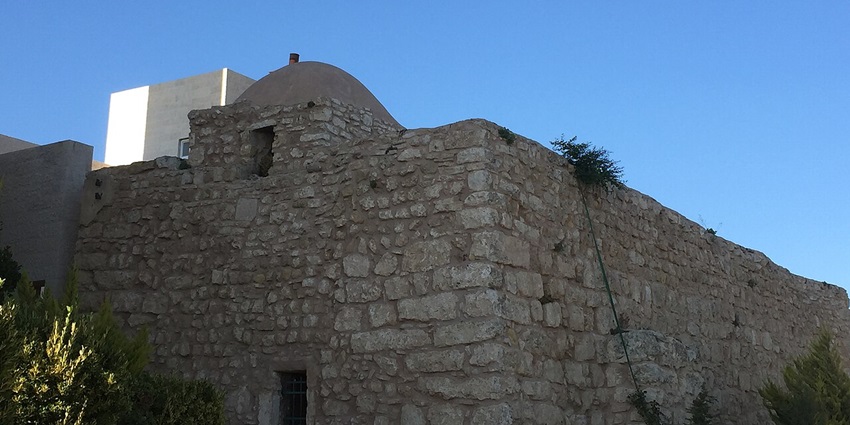
Photo: Bilal Dweik / Wikimedia Commons
On a high ridge overlooking the town of Salt, the shrine of Prophet Yusha offers one of the most peaceful and spiritually charged views in Jordan. According to Islamic tradition, Yusha (Joshua) was a close companion of Prophet Musa (Moses) and later a prophet himself. His burial site rests under a domed chamber, shaded by olive trees and cooled by mountain breezes. The path leading up to the shrine winds through quiet countryside, and reaching it feels like a personal journey. Among the many Islamic historical places in Jordan, this one is valued for its spiritual environment.
How To Reach: Located on a high hill near Salt town, it can be reached by car.
Timings: 8 AM – 4 PM.
Nearby Attractions: Prophet Shu’ayb’s Shrine, Salt Great Mosque, Al Hammam Street.
4. Cave Of The Seven Sleepers, Al Raqim
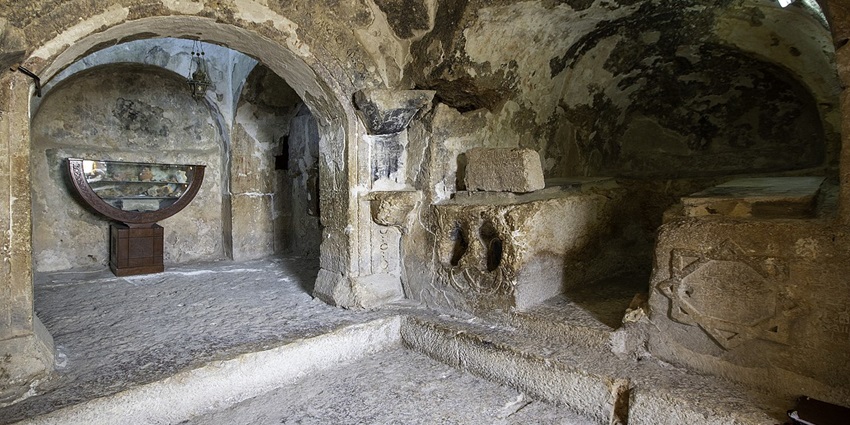
Photo: Bashar Tabbah / Wikimedia Commons
Just outside Amman, near the road that leads to Zarqa, lies a cave many believe to be the resting place of young men who took shelter from persecution and were granted divine sleep for centuries. The story appears in the Quran and holds meaning across different cultures, but here in Al Raqim, the setting is quiet and grounded. The cave is carved into the hillside and surrounded by olive trees, with a modest mosque and burial stones believed to belong to the sleepers. Pilgrims and families often stop to reflect on the sense of shelter it still seems to offer.
How To Reach: 10 km from Amman. Taxi or private vehicle recommended.
Timings: 8 AM – 4 PM.
Nearby Attractions: Amman Citadel, Qasr al-Abd, Al Hussein Park.
5. Shrine Of Prophet Harun (Aaron), Petra
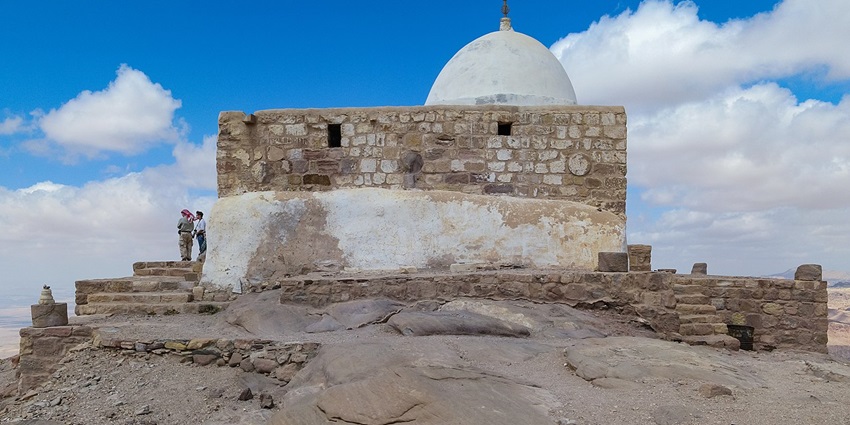
Photo: Joneikifi / Wikimedia Commons
Among the Islamic historical places in Jordan, high above the rugged landscape of Petra, on the summit of Jabal Harun, stands a quiet white-domed shrine believed to mark the burial place of Prophet Harun, the brother of Musa (Moses). The climb is long and often steep, taking visitors across sandstone paths, through windswept ridges, and past views that stretch endlessly into the horizon. The shrine itself is plain with white stone against ochre mountains.
How To Reach: Situated on Mount Harun above Petra. Reached via a guided hike or mule ride from Petra ruins.
Timings: 8 AM – 4 PM
Nearby Attractions: Petra Archaeological Park, Al-Khazneh, Siq Canyon.
6. Qasr Al-Kharraneh, Eastern Desert
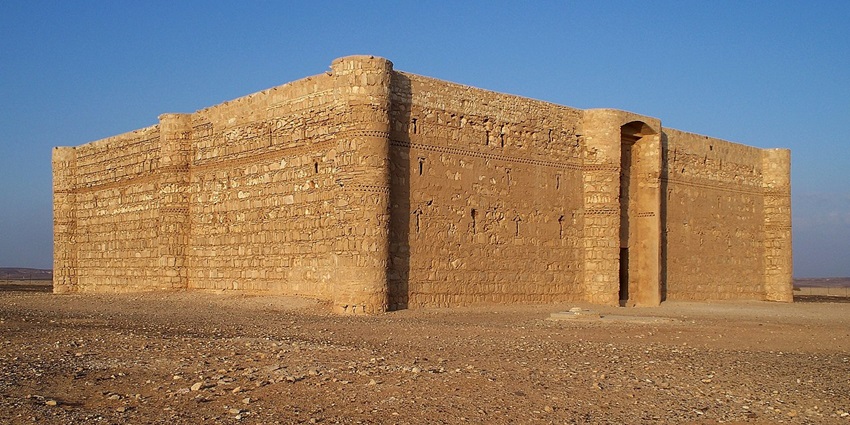
Photo: High Contrast / Wikimedia Commons
Rising from the flat expanse of Jordan’s eastern desert, Qasr Al-Kharraneh appears almost like a mirage. Its thick, symmetrical walls and square towers give it the look of a fortress, but historians believe it may have served more as a meeting place or rest stop during the early Islamic period. Built in the 8th century under Umayyad rule, the structure reflects a blend of architectural influence, with Roman-style arches inside and defensive elements outside. Step through its heavy doorway and the outside noise disappears, replaced by the soft echo of footsteps in stone corridors.
How To Reach: 60 km east of Amman. Best accessed by rental car or guided tour.
Timings: 8 AM – 4 PM
Nearby Attractions: Qasr Amra, Azraq Wetland Reserve, Qasr Azraq.
7. Qasr Amra (UNESCO World Heritage Site)
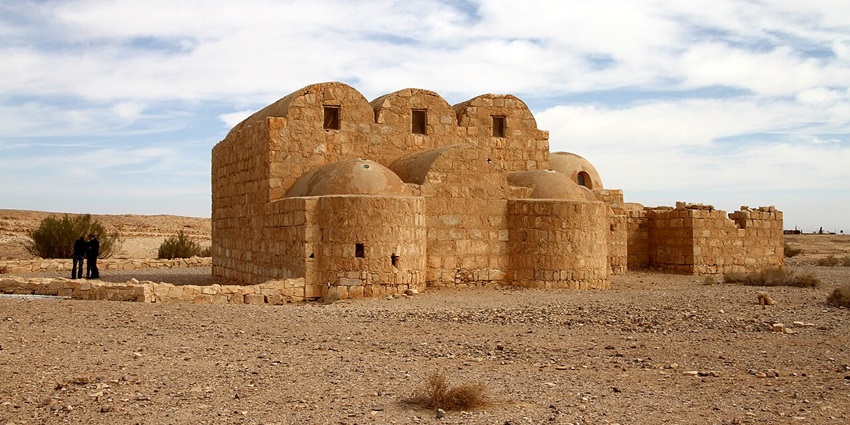
Photo: Gerd Eichmann / Wikimedia Commons
Qasr Amra is an early Islamic structure built during the 8th century under the Umayyads. The site has a rectangular main hall with three domes and a separate audience room. Its importance comes from the interior paintings, which show human figures, constellations, musicians, animals, and daily scenes from early court life. These frescoes are rare early Islamic art and have been preserved well over time. Qasr Amra is one of the best Islamic historical places in Jordan. It’s built from stone found nearby and has a plain, solid appearance.
How To Reach: 85 km east of Amman on the Desert Highway. Can be visited by car or in a desert castle tour.
Timings: 8 AM – 5 PM
Nearby Attractions: Qasr Al-Kharraneh, Qasr Azraq, Desert Castles Loop.
8. Ajloun Castle & Great Mosque Of Ajloun
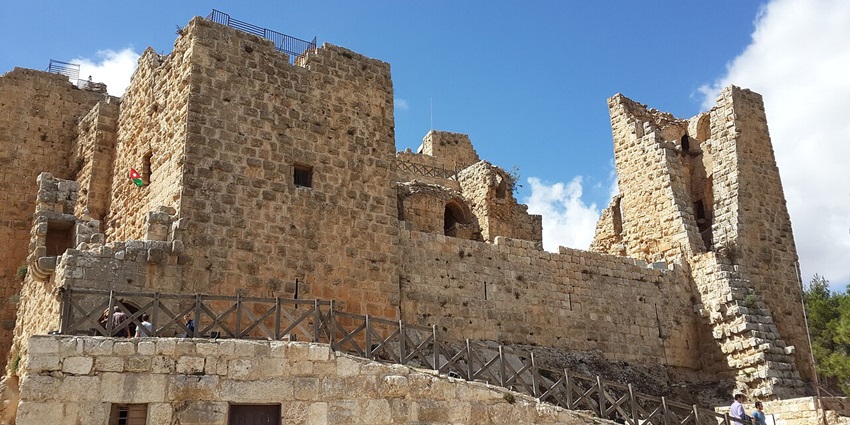
Photo: Freedom’s Falcon / Wikimedia Commons
Ajloun Castle was built in 1184 under the rule of Salahuddin’s general, Izz al-Din Usama. It was designed to defend against Crusader attacks and to monitor key trade and military routes. The structure stands on a hilltop and is made of local limestone, with solid walls, lookout towers, and narrow passageways. The surrounding hills and villages can be seen, which once gave the castle a strong defensive advantage. It is one of the oldest mosques still used for prayer and one of the Islamic historical places in Jordan.
How To Reach: About 76 km north of Amman. Buses from Tabarbour station or private taxis are available
Timings: 8 AM – 6 PM
Nearby Attractions: Ajloun Forest Reserve, Soap House, Mar Elias ruins.
9. Al-Hussein Bin Talal Mosque, Amman
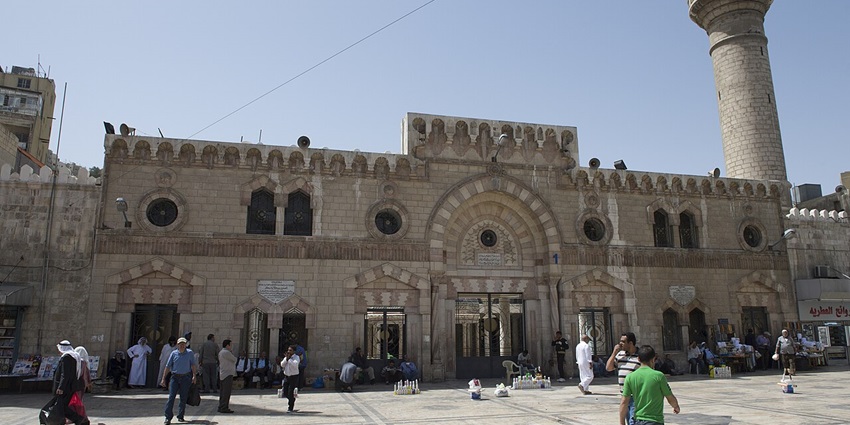
Photo: Dosseman / Wikimedia Commons
The mosque stands inside Al-Hussein Public Parks in west Amman. It was completed in 2005 and named after King Hussein bin Talal. It has four minarets and a central dome, with enough room for thousands of people. The design uses white stone and includes open spaces for prayer. Even though it was built recently, the style follows Islamic architectural traditions. The mosque is part of a large public area that also has museums and gardens visited by both locals and tourists.
How To Reach: Situated within Al-Hussein Public Parks. Easily accessible by taxi or public transport.
Timings: 24*7
Nearby Attractions: Royal Automobile Museum, King Hussein Park, The Children’s Museum.
10. Maqam Of Prophet Dawud (David), Mazar
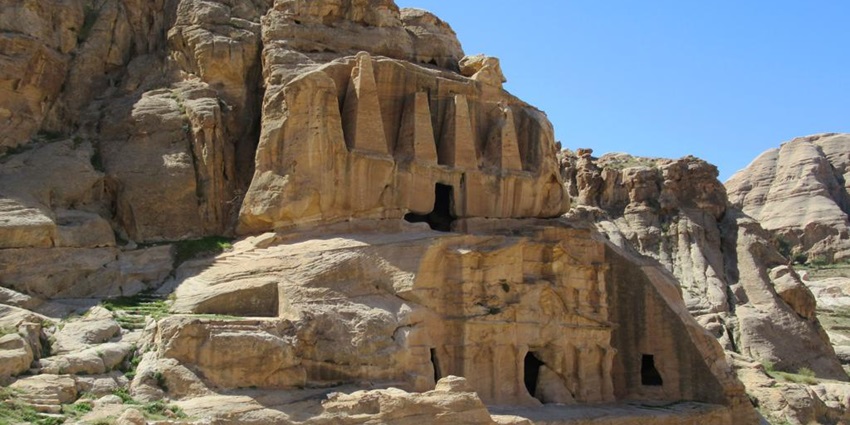
Photo: Obelisk Tomb / Wikimedia Commons
In the southern hills near Mazar, a quiet site marks what many believe is the final resting place of Prophet Dawud. Recognised in Islamic tradition as a prophet and king, his importance also extends to Christianity and Judaism. The shrine is simple, built from local stone, with a domed chamber and basic stone markers. People exploring Islamic historical places in Jordan visit here for its religious significance and the sincerity of the space. The shrine is part of a larger stretch of sacred places across Karak, and continues to be maintained by local families who understand its place in Jordan’s history.
How To Reach: Located near the town of Karak.
Timings: 8 AM – 4 PM
Nearby Attractions: Karak Castle, Umm Al-Tannour, Mujib Nature Reserve.
In Jordan, religious sites are part of everyday life. Families visit them, locals care for them, and prayers continue in these places without interruption. The Islamic historical places in Jordan include shrines in villages, mosques in busy neighbourhoods, and small tombs in quiet hills. Each place holds meaning because it has been respected over time. Explore more such packages offered by TripXL, and fulfil your travel dreams.
Cover Photo: Bernard Gagnon / Wikimedia Commons


 WhatsApp
WhatsApp
 Twitter
Twitter









